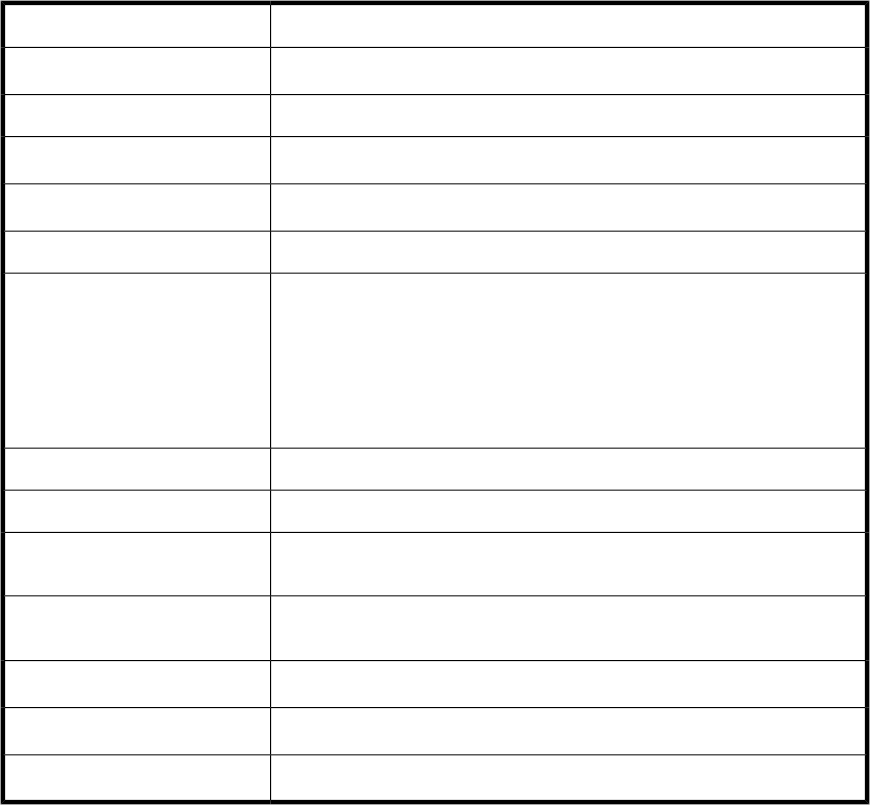HP XP7 Replication Manager Application Agent CLI Reference Guide (TK981-96014, May 2014)
Table Of Contents
- Application Agent CLI Reference Guide
- Preface
- 1 Extended commands
- Overview of extended commands
- Before reading the extended command descriptions
- Extended command specifications (File system backups)
- Extended command specifications (Common commands)
- EX_DRM_BACKUPID_SET (Generates a backup ID file)
- EX_DRM_CG_DEF_CHECK (Checks the contents of a copy-group list file)
- EX_DRM_DB_EXPORT (Exports backup information to a file)
- EX_DRM_DB_IMPORT (Imports backup information from a file)
- EX_DRM_FTP_GET (Acquires a backup information file from the backup server)
- EX_DRM_FTP_PUT (Transfers a backup information file to the backup server)
- EX_DRM_HOST_DEF_CHECK (Checks the contents of a host environment settings file)
- EX_DRM_RESYNC (Resynchronizes a copy group)
- Extended command specifications (Tape-related commands)
- Extended command specifications (SQL Server database backups)
- EX_DRM_SQL_BACKUP (Backs up an SQL Server database)
- EX_DRM_SQL_DEF_CHECK (Checks the contents of an operation definition file and automatically creates a temporary directory)
- EX_DRM_SQL_RESTORE (Restores an SQL Server database backup to the primary volume)
- EX_DRM_SQL_TLOG_BACKUP (Backs up the transaction log of the SQL Server)
- EX_DRM_SQLFILE_EXTRACT (Deploys SQL Server metafiles to the folder to be backed up to a tape device)
- EX_DRM_SQLFILE_PACK (Saves SQL Server metafiles)
- Extended command specifications (Exchange database backups)
- EX_DRM_EXG_BACKUP (Backs up an Exchange database)
- EX_DRM_EXG_DEF_CHECK (Checks the contents of an operation definition file and automatically creates a temporary directory)
- EX_DRM_EXG_RESTORE (Restores an Exchange database backup to the primary volume)
- EX_DRM_EXG_VERIFY (Verifies the consistency of an Exchange database)
- 2 Basic commands
- List of basic commands
- Before reading the basic command descriptions
- Basic command specifications (File system backups)
- Basic command specifications (Common commands)
- drmappcat (Views catalog information on a host)
- drmcgctl (Locks or unlocks a copy group)
- drmclusinit (Registers the parameters for the cluster software)
- drmdbexport (Exports backup information to a file)
- drmdbimport (Imports backup information from a file)
- drmdevctl (Conceals and reveals a physical volume)
- drmhostinfo (Displays host information)
- drmresync (Resynchronizes copy groups)
- Basic command specifications (Tape-related commands)
- drmmediabackup (Backs up data from a secondary volume to a tape device)
- drmmediarestore (Restores data from a tape device to a secondary volume)
- drmmount (Mounts a secondary volume)
- drmtapecat (Displays or deletes backup information in a backup catalog)
- drmtapeinit (Registers parameters for a backup management product)
- drmumount (Unmounts secondary volumes)
- Basic command specifications (Utility commands)
- Basic command specifications (SQL Server database backups)
- drmsqlbackup (Backs up an SQL Server database to a secondary volume)
- drmsqlcat (Displays backup information for an SQL Server database)
- drmsqldisplay (Displays or updates information for an SQL Server database)
- drmsqlinit (Registers parameters for SQL Server)
- drmsqllogbackup (Backs up the transaction log of an SQL Server)
- drmsqlrecover (Recovers restored SQL Server databases)
- drmsqlrecovertool (Recovers restored SQL Server databases via a GUI)
- drmsqlrestore (Restores SQL Server databases from backups to a primary volume)
- Basic command specifications (Exchange database backups)
- drmexgbackup (Backs up an Exchange database)
- drmexgcat (Displays backup information for an Exchange database)
- drmexgdisplay (Displays or updates information for an Exchange database)
- drmexgrestore (Restores an Exchange database backup to the primary volume)
- drmexgverify (Verifies the consistency of an Exchange database)
- 3 Support and other resources
- Index

Description
The drmtapecat command lists the backup information about tape backups, which is stored in the
backup catalog on the server where the command was executed. The backup catalog displayed is
that created with the drmmediabackup command. By checking the backup information, you can
confirm information about the objects corresponding to the backup ID, and hence confirm the backup
ID to be used for restoration.
The backup information for the backup from the primary volume to the secondary volume contains
the information about the primary volume that stores objects that were backed up onto a tape device,
and the information about the database files that were backed up.
The following table shows the backup information, from the secondary volume to a tape device, which
is displayed when the drmtapecat command is executed.
Table 35 Backup information displayed by the drmtapecat command
DescriptionDisplayed item
Backup comment
BACKUP-COMMENT
#1
Backup ID (10 characters)BACKUP-ID
Original backup ID obtained by the drmmediabackup command
ORIGINAL-ID
#2
Server name where the snapshot backup was performed
HOSTNAME
#2
Snapshot backup object typeBACKUP-OBJECT
Name of the instance that was backed up:
• When the backup is of a file system, the name of the mount point direct-
ory is displayed.
• When the backup is of an SQL Server database, the name of the SQL
Server instance is displayed.
• When the backup is of an Exchange database, - is displayed.
INSTANCE
#2
Time when a snapshot backup was performedSNAPSHOT TIME
Duration of the backup data on a tape deviceEXPIRATION TIME
Name of the media label that the backup management product used when
backing up data to a tape device
BACKUP-MEDIA
#3
The backup file storage directory backed up with the drmmediabackup
command.
BACKUP-FILE-DIRECTORY
#4
Virtual server name (value of the DRM_HOSTNAME environment variable)
VIRTUAL-SERVERNAME
#5
Name of the directory storing the backup catalog
DB-PATH
#5
Time when the backup catalog was created
CATALOG-UPDATE-TIME
#6
#1
When the -comment option is specified, these items are displayed.
#2
When the -l option is specified, these items are displayed.
#3
Basic commands132










